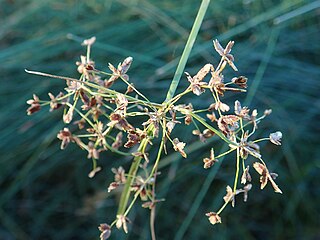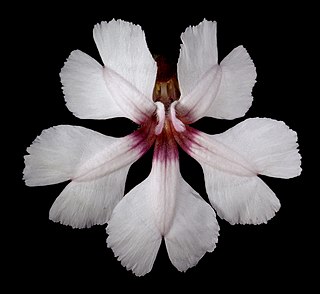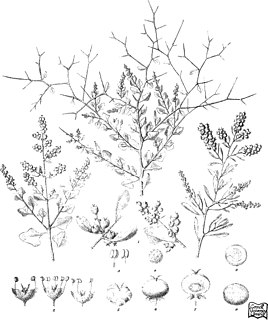
Flora of Australia is a 59 volume series describing the vascular plants, bryophytes and lichens present in Australia and its external territories. The series is published by the Australian Biological Resources Study who estimate that the series when complete will describe over 20 000 plant species. It was orchestrated by Alison McCusker.

The National Herbarium of Victoria is one of Australia's earliest herbaria and the oldest scientific institution in Victoria. With 1.5 million specimens, it houses the largest collection of pressed, dried plant specimens in Australia, including scientifically and historically significant collections gathered by Joseph Banks and Daniel Solander during the voyage of HMS Endeavour in 1770, 2,000 specimens collected by Robert Brown during Flinders' circumnavigation of Australia (1801–1805), and three collections made by Darwin during the Voyage of the Beagle to South America, Australia, and the Pacific. The herbarium was established in 1853 by Ferdinand von Mueller, the Government Botanist for Victoria, and is situated within the Royal Botanic Gardens, Melbourne. The present building was constructed in 1934 through a donation from philanthropist Sir Macpherson Robertson. It, along with a 1989 extension, houses the entire collection of 1.5 million plant and fungal specimens. The Herbarium's botanic library is an important source for the history of Australian botany, and has contributed some 124 volumes to the online digital Biodiversity Heritage Library.

Thysanotus patersonii, the twining fringe-lily, is a climbing perennial herb which is endemic to Australia.

Velleia montana is a perennial herbaceous plant that is native to New South Wales, Victoria, and Tasmania in Australia, growing mainly in woodland and sub-alpine grasslands, and at higher altitudes south from Boonoo Boonoo. It has oblanceolate to obovate leaves that are 1.5 to 8 cm long and 6 to 30 mm wide. The yellow flowers have a 7 to 10 mm corolla. It blooms from November to February. The Latin specific epithet montana refers to mountains or coming from mountains.
Plantago debilis is a species of herb native to Australia. Common names include shade plantain and weak plantain.

Parsonsia straminea, commonly known as common silkpod or monkey rope, is a woody vine of the dogbane family, Apocynaceae. It occurs in the states of New South Wales and Queensland in Australia.

Geranium potentilloides, belonging to the family Geraniaceae, is a small leafy perennial herb that can grow up to 50cm high and is commonly referred to as Mountain Cranesbill or Soft Cranesbill. This Geranium species is native to the eastern half of Australia as well as New Zealand and Indonesia. G. potentilloides is commonly found in woodlands, grasslands and moist forested areas. In Tasmania, Australia it is also found on eastern and central mountains up to 1000m.

Cryptocarya triplinervis is a rainforest tree growing in eastern Australia. Common names include the three veined laurel, three veined cryptocarya and the brown laurel.

The National Herbarium of New South Wales was established in 1853. The Herbarium has a collection of more than 1.4 million plant specimens, making it the second largest collection of pressed, dried plant specimens in Australia, including scientific and historically significant collections and samples of Australian flora gathered by Joseph Banks and Daniel Solander during the voyage of HMS Endeavour in 1770.

Cuscuta australis, commonly known as Australian dodder, is a herb in the family Convolvulaceae.

Cyperus concinnus is a sedge of the family Cyperaceae that is native to Australia, and found in New South Wales, Queensland, the Northern Territory, South Australia, Victoria and Western Australia.

Velleia lyrata is a small perennial herb in the family Goodeniaceae, endemic to Australia. It is found mainly near Sydney, but also near the NSW and Queensland border, and in Queensland. A map of its occurrence records is given here. It grows in damp situations in heath on sandy soils. The cordate base to the adaxial sepal is a feature distinguishing it from many other Velleias. A full description of the plant is given in Flora of Australia online.

Velleia rosea is a member of the family Goodeniaceae that is native to Western Australia and flowers from April to October.

Chenopodium spinescens is a species of plant in the family Amaranthaceae, endemic to Australia. It is found in all states and territories of Australia with the exception of Tasmania.

Velleia connata is an erect annual herb in the family Goodeniaceae, and is found in all mainland states and territories of Australia. It grows on sandplains and stony hills in Beard's eremaean province. Its flowers are yellow-brown or white-pink and it flowers mainly from February or May to October.

Velleia macrophylla, or large-leaved Velleia, is a perennial herb in the family Goodeniaceae, which is endemic to Western Australia. It grows on moist sites in Beard's South-west province. It flowers from October to December or January.

Velleia glabrata is an annual herb in the family Goodeniaceae, which is native to all mainland states and territories of Australia with the exception of Victoria. It grows on sand and clay, flowering from June to October.

Bertya gummifera, is a sticky shrub in the family Euphorbiaceae, endemic to New South Wales. It grows in woodland and often in sandstone areas. It flowers in spring.

Exocarpos aphyllus belongs to the sandalwood plant family (Santalaceae). Noongar names are chuk, chukk, dtulya and merrin. It is a species endemic to Australia.

Fimbristylis velata is a species of sedge native to the North Island of New Zealand and Australia, where it is found in Western Australia, New South Wales, the Northern Territory, Queensland, Victoria, and South Australia.



















